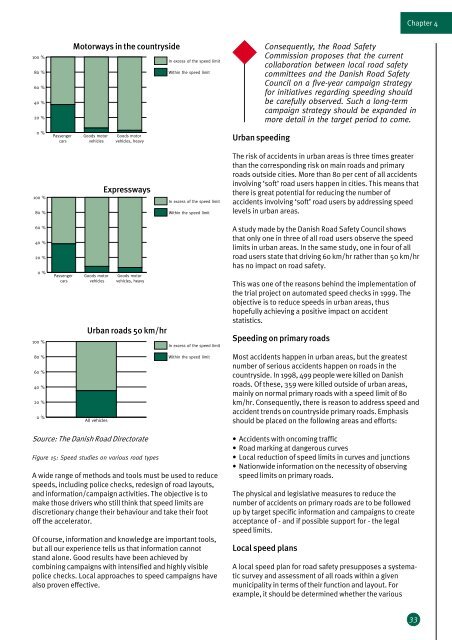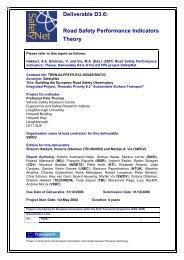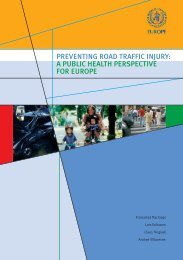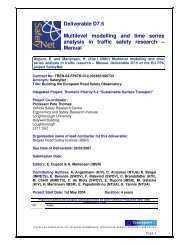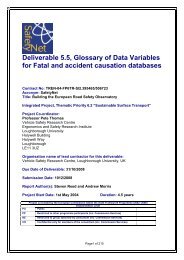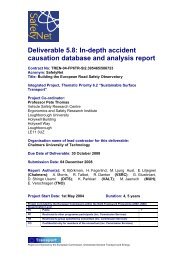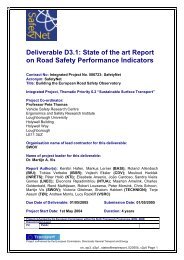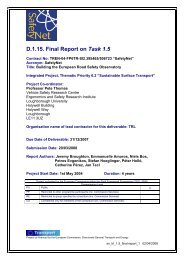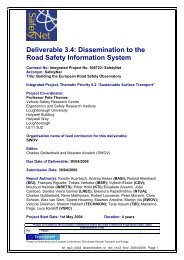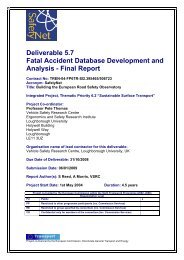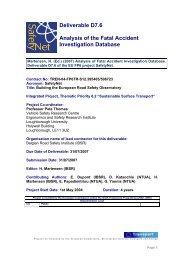Every Accident is One Too Many Every Accident is One ... - UNECE
Every Accident is One Too Many Every Accident is One ... - UNECE
Every Accident is One Too Many Every Accident is One ... - UNECE
You also want an ePaper? Increase the reach of your titles
YUMPU automatically turns print PDFs into web optimized ePapers that Google loves.
Chapter 4<br />
100 %<br />
80 %<br />
60 %<br />
40 %<br />
20 %<br />
Motorways in the countryside<br />
In excess of the speed limit<br />
Within the speed limit<br />
Consequently, the Road Safety<br />
Comm<strong>is</strong>sion proposes that the current<br />
collaboration between local road safety<br />
committees and the Dan<strong>is</strong>h Road Safety<br />
Council on a five-year campaign strategy<br />
for initiatives regarding speeding should<br />
be carefully observed. Such a long-term<br />
campaign strategy should be expanded in<br />
more detail in the target period to come.<br />
0 %<br />
Passenger<br />
cars<br />
Goods motor<br />
vehicles<br />
Goods motor<br />
vehicles, heavy<br />
Urban speeding<br />
100 %<br />
80 %<br />
Expressways<br />
In excess of the speed limit<br />
Within the speed limit<br />
The r<strong>is</strong>k of accidents in urban areas <strong>is</strong> three times greater<br />
than the corresponding r<strong>is</strong>k on main roads and primary<br />
roads outside cities. More than 80 per cent of all accidents<br />
involving ‘soft’ road users happen in cities. Th<strong>is</strong> means that<br />
there <strong>is</strong> great potential for reducing the number of<br />
accidents involving ‘soft’ road users by addressing speed<br />
levels in urban areas.<br />
60 %<br />
40 %<br />
20 %<br />
0 %<br />
100 %<br />
Passenger<br />
cars<br />
Goods motor<br />
vehicles<br />
Goods motor<br />
vehicles, heavy<br />
Urban roads 50 km/hr<br />
In excess of the speed limit<br />
A study made by the Dan<strong>is</strong>h Road Safety Council shows<br />
that only one in three of all road users observe the speed<br />
limits in urban areas. In the same study, one in four of all<br />
road users state that driving 60 km/hr rather than 50 km/hr<br />
has no impact on road safety.<br />
Th<strong>is</strong> was one of the reasons behind the implementation of<br />
the trial project on automated speed checks in 1999. The<br />
objective <strong>is</strong> to reduce speeds in urban areas, thus<br />
hopefully achieving a positive impact on accident<br />
stat<strong>is</strong>tics.<br />
Speeding on primary roads<br />
80 %<br />
60 %<br />
40 %<br />
20 %<br />
0 %<br />
All vehicles<br />
Within the speed limit<br />
Most accidents happen in urban areas, but the greatest<br />
number of serious accidents happen on roads in the<br />
countryside. In 1998, 499 people were killed on Dan<strong>is</strong>h<br />
roads. Of these, 359 were killed outside of urban areas,<br />
mainly on normal primary roads with a speed limit of 80<br />
km/hr. Consequently, there <strong>is</strong> reason to address speed and<br />
accident trends on countryside primary roads. Emphas<strong>is</strong><br />
should be placed on the following areas and efforts:<br />
Source: The Dan<strong>is</strong>h Road Directorate<br />
Figure 15: Speed studies on various road types<br />
A wide range of methods and tools must be used to reduce<br />
speeds, including police checks, redesign of road layouts,<br />
and information/campaign activities. The objective <strong>is</strong> to<br />
make those drivers who still think that speed limits are<br />
d<strong>is</strong>cretionary change their behaviour and take their foot<br />
off the accelerator.<br />
Of course, information and knowledge are important tools,<br />
but all our experience tells us that information cannot<br />
stand alone. Good results have been achieved by<br />
combining campaigns with intensified and highly v<strong>is</strong>ible<br />
police checks. Local approaches to speed campaigns have<br />
also proven effective.<br />
• <strong>Accident</strong>s with oncoming traffic<br />
• Road marking at dangerous curves<br />
• Local reduction of speed limits in curves and junctions<br />
• Nationwide information on the necessity of observing<br />
speed limits on primary roads.<br />
The physical and leg<strong>is</strong>lative measures to reduce the<br />
number of accidents on primary roads are to be followed<br />
up by target specific information and campaigns to create<br />
acceptance of - and if possible support for - the legal<br />
speed limits.<br />
Local speed plans<br />
A local speed plan for road safety presupposes a systematic<br />
survey and assessment of all roads within a given<br />
municipality in terms of their function and layout. For<br />
example, it should be determined whether the various<br />
33


